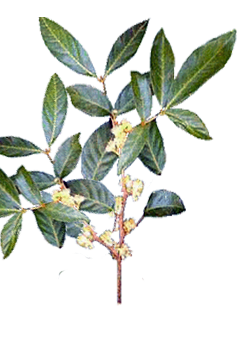Ptychopetalum olacoides
| Ptychopetalum olacoides | ||||||||||||
|---|---|---|---|---|---|---|---|---|---|---|---|---|

Ptychopetalum olacoides |
||||||||||||
| Systematics | ||||||||||||
|
||||||||||||
| Scientific name | ||||||||||||
| Ptychopetalum olacoides | ||||||||||||
| Benth. |
Ptychopetalum olacoides is a species of plant from the family Olacaceae in the order of the sandalwood-like (Santalales). Ptychopetalum uncinatum, which is also named the same, isvery similar.
Trivial name in different languages
This type is used by the Indians as Muirapuama , in the English language as Muira puama and in German language as power tree or the product as potency wood called.
description
Vegetative characteristics
Ptychopetalum olacoides grows as a small tree with a longitudinally furrowed bark , which reaches heights of growth of 5 to 15 meters and a trunk diameter of up to 25 centimeters. The simple, short-stalked leaves are arranged alternately on the branches. The entire, slightly leathery and bald leaf blade is ovate to lanceolate and pointed to acuminate with a length of up to 9-11 centimeters and a width of 2.5 to 3.5 centimeters. The leaf blade is “frosted” on the underside, greyish to bluish.
Generative characteristics
Ptychopetalum olacoides is heterostyle and distyle as well as hermaphroditic. The axillary inflorescence is racemose , short and has few flowers . The stalked flowers with a double flower envelope have 7–10 stamens of unequal length and an upper, single-chamber ovary . The stylus is relatively short and sealed with a lobed stigma . The flowers have a sloping bract . The toothed and cup-shaped calyx is very small to minimal. The white, narrow and inside more or less hairy, usually 5 petals are oblong with a length of up to 1.3 centimeters.
The egg-shaped to ellipsoidal and solitary stone fruits are up to 1.5–1.8 centimeters long, initially green, changing from pink to purple-black as they ripen.
Occurrence
Ptychopetalum olacoides occurs in northern South America, in French Guiana , Guyana and Suriname, and in Brazil in the states of Amapá , Amazonas and Pará . It grows in the rainforest and in high savannah forests , it does not occur on flooded soils .
use
Ptychopetalum olacoides has been exported to Europe for over 100 years. The pharmaceutical drug Muira puama lignum , the “potency wood”, is obtained from the wood and roots of Ptychopetalum olacoides (but also from other Ptychopetalum species and from Liriosma ovata ) . Among other things, it is said to have an aphrodisiac effect, but the effect has not been proven.
literature
- Daniel Oliver : Flora of Tropical Africa. Volume 1, Reeve, 1868, p. 347.
- J. Kuijt, B. Hansen: The Families and Genera of Vascular Plants. Vol. XII: Flowering Plants Eudicots , Springer, 2015, ISBN 978-3-319-09295-9 , p. 134.
Web links
- Plantgenera.org: Ptychopetalum olacoides ( illustration )
- Ptychopetalum olacoides at Tropicos.org. Missouri Botanical Garden, St. Louis.
- Ptychopetalum olacoides at NYBG.
- Ptychopetalum olacoides at Useful Tropical Plants.
Individual evidence
- ↑ a b AF Correia et al. : Amazonian plant crude extract screening for activity against multidrug-resistant bacteria. In: European Review for Medical and Pharmacological Sciences Volume 12 (6), 2008, pp. 369-380. ( Link to the full text ; accessed on August 20, 2012).
- ↑ a b c d Rudolf Hansel , Konstantin Keller, Horst Rimpler: Hager's handbook of pharmaceutical practice. Drugs: P-Z , Springer, 1994, ISBN 3-540-52639-0 , pp. 307-310.
- ^ Ptychopetalum olacoides in the Germplasm Resources Information Network (GRIN), USDA , ARS , National Genetic Resources Program. National Germplasm Resources Laboratory, Beltsville, Maryland.